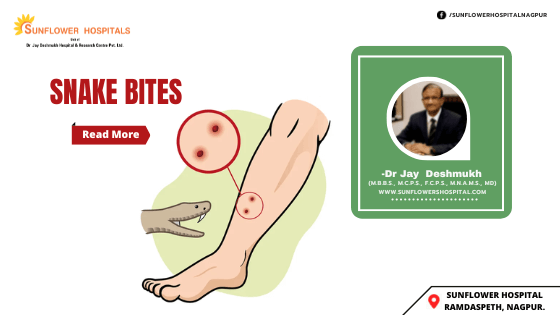Why are snake bites dangerous?
Different types of snakes carry different venoms. The major categories include Cytotoxins which cause swelling and tissue damage where ever you have been bitten. Some toxins disrupt the blood vessels. Some venoms prevent blood from clotting. Some venoms have neuro-toxins that cause paralysis or other damage to the nervous system. Certain venoms can cause severe muscle breakdown and kidney failure.
What are the symptoms of a snake bite?
Symptoms differ according. ing to the bite of the snake and the type of the snake. Perhaps only local swelling and redness will be the symptoms of non-venom-ous or non-poisonous snake bites. If it is a venomous snake, the symptoms may differ and they could be widespread. At times there could be just biting marks. Sharp, shooting burning pain around the bite may occur after a while. The pain may extend upwards in the limb. There could be redness, swelling and tissue damage at the local site. There could be abnormal blood clotting or bleeding that can lead to kidney failure or haemorrhage. Low blood pressure, faster heart rate and a weaker pulse are common in poisonous bites. There could be a weakness in the muscles and numbness in the face or limbs. Nausea, vomiting, diarrhoea, anxiety, headaches, and dizziness are common. There could be severe difficulty in breathing or complete loss of breath.
What is the FIRST AID?
Remove the patient from the snake’s territory, keep him calm and at rest remaining as still as possible. Attempt to identify the type of snake only if it is safe. The bite reflex may remain intact in a recently killed snake and further bites are possible. Remove jewellery from the affected limb, footwear can be removed, and other clothing not to be removed unless very tight. Splint the extremity
should apply a tourniquet, suck out the poison and spit it out.
What is the definitive treatment?
Anti venoms consist of animal immunoglobulins developed against the whole venom. The process involves immunising animals commonly horses, sheep or goats with the snake venom and extracting the anti-venom from the animal blood. The decision to administer anti venom is based on clinical findings and the risk of adverse reactions. Polyvalent antivenins are developed against venoms from multiple different snakes that share a typical geographic region. Haffitine Institute in Mumbai is a pioneer in pro- Snake bites are common in the monsoon season both in rural and some urban areas as well. Though some are dry bites which are not dangerous and would just cause local swelling, others are venomous bites which if not recognised and treated early can even lead to death. One should always seek immediate medical help if bitten by a snake, as it could be a matter of life and death. Wherever possible the snake should be identified by examination. Once bitten the individuals are also tetanus prone. by wood or rolled paper immobilising the arm or knee and ankle. Transport him to the nearest medical facility. Do not allow him to walk as local muscle contraction may increase snake venom absorption. Immobilisation and pres. sure at the local site is done in selected cases.
What are the methods to be avoided?
Some methods do more harm than good. Incision and oral suction should be avoided. Mechanical suction devices, cryotherapy, surgery, electric shock therapy and tourniquets should be avoided. A common misconception is that one during antivenom.
What causes failure to respond to anti-venom?
It could be a wrong anti-venom, insufficient dose, inactive or a poor quality ant•venom, excessive delay in administration and a venom effect not reversed by anti-venom as in neurotoxicity paralysis. Some allergic reactions may occur due to antivenoms, but most are easily managed. Some patients may require dialysis support or ventilatory support.
How do identify snakes according to the symptoms?
At times the snakes are not seen after the bites. If there is a marked local swelling it is considered poisonous. If there is non-clotting of blood and neurotoxic signs with renal failure then Russell’s viper bite is a possibility. If there is early blistering necrosis and no problems in the clotting of blood then it is likely to be a Cobra bite. If there are no local signs, but neurotoxic signs and bitten on land, sleeping on the floor of a house it is likely to be a krait bite. If bitten in the sea it is a sea snake bite. If identification of a snake is difficult, then a photo. the graph should be taken if possible.
What is the treatment given in the hospital?
If there is pain, fang marks, swelling, blistering and local lymph nodes swelling and pain, anti-venom is given. Those with drooping of eyelids, double vision, difficulty in swallowing, breathing difficulty and limb weakness, anti-venom, Neostigmine, maintaining airways and assisted breathing may be required. Those with nose bleeds, bleeding from puncture sites, blood in urine, sputum, blood vomiting or brain haemorrhage will require anti-snake venom and later blood, plasma or platelets infusion. Some present with shock in terms of low blood pressure, fast pulse rate, and cold extremities will require anti-snake venom and intravenous fluids. Those with dark brown urine who have rhabdomyolysis with a low urine output will require intravenous fluids and dialysis in almost all cases. Snake bites are medical emergencies. Prompt recognition of the type of snake may help. Transportation to a centre where treatment and expertise are available is important. Local tissue necrosis, paralysis, bleeding disorders, shock and kidney failure are important symptoms of poisonous snake bites.
Author: Dr Jay Deshmukh
Dr Jay Deshmukh is Chief Physician and Director, Sunflower Hospital, Nagpur Honorary Physician to Honorable Governor of Maharashtra and PondicherryCentral. Dr Jay Deshmukh is an M.B.B.S., M.C.P.S., F.C.P.S., M.N.A.M.S., MD From Internal Medicine – Bombay and New Delhi.


